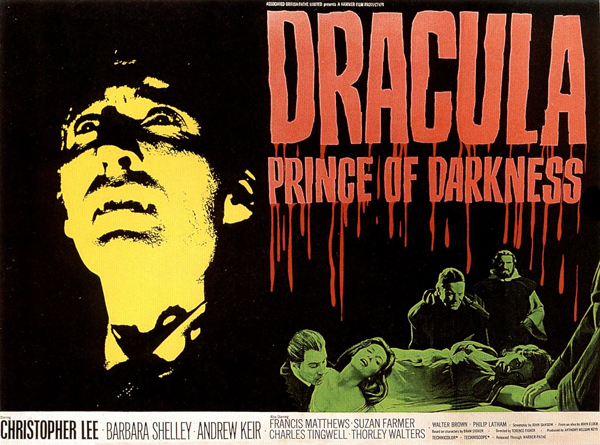Good things are worth waiting for. Nobody knows this better certainly than the Undead. I mean, really, it might take centuries for that unsuspecting village idiot to sneak into the castle and open up the family crypt. In cases like that, patience definitely is a virtue.
But even given that truism, the eight years that passed between the classic Hammer Films Horror of Dracula (1958) and equally influential Dracula: Prince of Darkness (1966) was almost unthinkable given the success that the studio and its stars enjoyed during the early 60’s. The Hammer films’ ethos of goth, gore and girls had been a smash on both sides of the Atlantic. And had made an international horror star of its most regular villain/anti-hero, Peter Cushing.
Cushing had taken the ball (or more perhaps appropriately, the brain) that had started rolling with 1957’s The Curse of Frankenstein and run with it, appearing in three films in seven years as a variation of everybody’s favorite mad scientist, Victor Frankenstein. Coupled with his prolific turn at evil, Cushing had even reprized his Horror performance as vampire-killing good-guy, Abraham Van Helsing in 1960’s The Brides of Dracula to campy renown.
Almost every year of the early sixties had featured another Hammer triumph for Cushing. But what had been the fate of the tall, gaunt, baritone-voiced specter who had stolen the show as the villain of Horror of Dracula? What had ever happened to Christopher Lee?
Well, in one sense, Lee had been hiding in plain sight. After completing Horror of Dracula, Lee had gone onto success in a slew of other films, working around the world with playing characters from Sherlock Homes to Fu Manchu (yes, folks, Fu Manchu). 1963 had seen him star in Italian Giallo creator Mario Bava’s scandal ridden S&M film, The Whip and the Body. But despite being a stable player for Hammer in a slew of other films, he’d never had revisited the role that many felt was his defining one: Dracula.
Compared to the success of Cushing in the Hammer firmament, Lee was still lurking in the monster-movie equivalent of the Minor Leagues. It was left to producer Anthony Nelson Keyes and Hammer go-to director, Terrence Fisher to get Lee to bear the fangs again. Though he had been stung emotionally by the lack of screen time in Horror and physically by the bulky contacts that he had been forced to wear when Dracula’s blood-lust emerged, the promise of a featured role without the presence of his acting foil, Cushing, was enough to make the Prince of Darkness live again.
Screenwriter John Elder had formulated a continuous storyline for a whole new series of Dracula movies. Movies that would allow Lee to be completely at center stage as “the world’s most evil man,” returning again and again to terrorize the unsuspecting populace and biting enough girls in low-cut blouses to keep the young males that Hammer was targeting happy.
The only problem was….They didn’t want him to say anything.
On one hand, the idea on not using Lee’s amazingly rich, deep voice to chill the viewing audience seem absurd. It’s still one of his foremost attributes, still on display in his modern performances in Peter Jackson’s LOTR and The Hobbit films in this, the actor’s 91st year and his 65th in feature films. But on a second glance, the decision to have the Count give nod to the silent horror cinema of the 20’s was a stroke of genius on Fisher and Lee’s part.
Let’s remember the tenor of the times. Toshrio Mifune had become a international superstar portraying grim-faced, nearly silent samurai heroes for such directors as Kurosawa during the late 50’s and early 60’s. And the two years preceding had seen an unknown TV cowboy actor named Clint Eastwood skyrocket into world cinema consciousness as the equally silent, equally iconic Man with No Name. So despite a thirty year history of needing actors with good voices to sell a film, the time for a silent, menacing Count Dracula had come.
Gathering a solid cast of previous horror players including British scream queen Barbara Shelly (Village of the Damned, The Gorgon) as Dracula’s victim and eventual vampiric partner, Prince of Darkness takes viewers through the classic vampire themes of the spooky house, the lurking man-servant henchman (played to campy perfection by horror specialist Philip Latham), gruesome re-birth scene and subsequent mayhem caused by a unleashed Dracula. Add in an unorthodox vampire-hunting monk (played by Andrew Kier), a bug-eating thrall (played by the Watson of the Sherlock Homes movies the 50’s, Thorley Walters) and the proto-psychedelic set design and lighting of Fisher and you’re off to the races.
Much of the look of the film would be a touchstone for Francis Ford Coppola’s interpretation of the mythology and Lee’s performance has informed other versions of the character ever since, proving that seduction and menace for vampires doesn’t need a lot of a dissembling. It’s in the eyes, baby, and in Prince of Darkness, the eyes have it.
FINI-JMS
P.S.- Strangely, this is one of the most difficult Hammer films to find on this side of the pond. The US release of Prince of Darkness was bizarrely rare until 2013 and even then the transfer quality was awful in many cases.
The newly revived Hammer Films came to the rescue this year with a Blu-Ray version that is reportedly superb. My personal DVD standard transfer copy by Millennium Films looks great on most monitor platforms, but be prepared to do some legwork if you want one, ’cause it’s one of the few things in the world that Amazon ain’t got. Consult with your local horror movie retailer or contact me here at TVS if you need some buying info.

